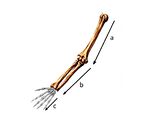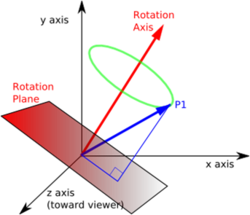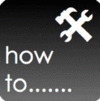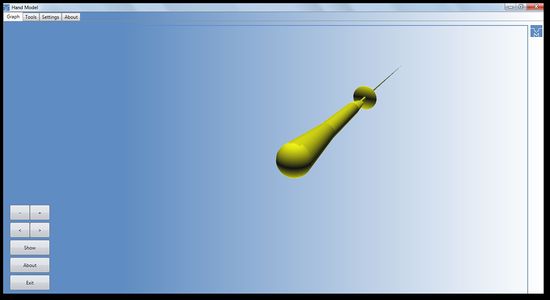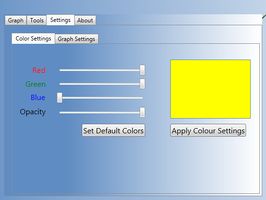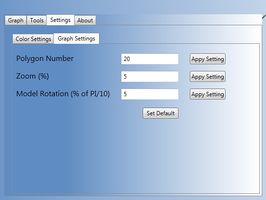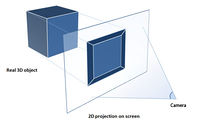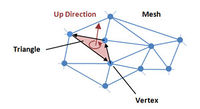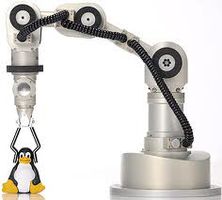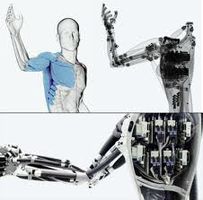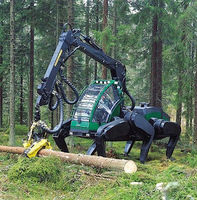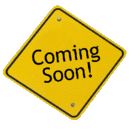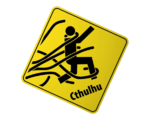Manipulator model
Содержание
Description
This is the page of a project related to project "Fencing".
Developers
Global Task
The main aim of this project is development of a program which will be useful for recording and calculation of manipulator's movement.
Current task
Current task is development of fencer's hand model. That means to create mathematical model, that finds the position of a hand and comes to this position from any previous position with visualization on C# language, using parameters (changes of angles in joints and coordinates of a shoulder)
Some information about modelling
Degrees of freedom
This model has 9 degrees of freedom:
2 — translation movement of a shoulder (front/back; up/down)
3 — shoulder joint as a ball joint
1 — elbow joint
1 — rotation of wrist round it’s axis
2 — wrist (2 perpendicular cylindrical joints)
Hand rotation
In order to rotate any 3D object we should rotate related vector.
But how to rotate vector?
This programm uses quaternions for vector rotation.
Quaternions
Usually quaternions are defined as a number system that extends the complex numbers to 4D space. In a simplier way we can define quaternions as 4 numbers with specific operations and properties.
, where i,j,k satisfies
Useful formulas
We are going to use quaternion written as
- where - scalar and - vector
In these terms we have rotation quaternion
This is the quaternion that rotates round vector on angle
- conjugated quaternion
- norm of quaternion
- reverse quaternion
- quaternion multiplication
Rotate vector
In order to rotate the vector we need to go through the following steps:
1) Cast vector to quaternion It's easy to make quaternion of vector. Just add zero to the scalar part and your vector to the vector part of quaternion
2) Multiply
Now we have quaternion rotated.
3)Cast back After all we should cast quaternion to vector . It's as easy as first cast, just forget about scalar part. Vector part of is ours vector.
Rotation
OK! We already can rotate any vector around any on any angle (but not bigger than 180deg)!
But it's not enough. We want to get motion and it should be smooth. So we need to go through many points between each position. There is a problem that appears if we try to rotate vector around two axis at the same time. Rotations are not additive, so we can't just rotate on a small angle each step. The solution is simple, we need to rotate vector on bigger angle on each step from the initial position.
About program interface
Because program doesn't have help yet, I should give some information about it's interface.
I'll tell about each tab:
Graph
This tab is responsible for visualization of movement. There are some keys working on this tab:
Up/Down – rotation around horizontal axis
Left/Right – rotation around vertical axis
Ctrl + Up/Down/Left/Right – faster rotation
+/- (OemPlus/OemMinus) –Foundation Zoom
Settings
This one is responsible for customization of model appearance. You can change model color and opacity, quality and speed of basis rotation.
3D Graphics realization
Program interface is developed by using special library WPF (Windows Presentation Foundation) and Microsoft Visual Studio's built-in XAML redactor.
- What is WPF:
“The Windows Presentation Foundation is Microsoft’s next generation UI framework to create applications with a rich user experience. It is part of the .NET framework 3.0 and higher.
WPF combines application UIs, 2D graphics, 3D graphics, documents and multimedia into one single framework. Its vector based rendering engine uses hardware acceleration of modern graphic cards. This makes the UI faster, scalable and resolution independent. etc.”
- Viewport3D element:
Graphics contents in 3-D WPF application is encapsulated in Viewport3D element, which can be placed on two-dimensional element such as program window. Graphics system identifies Viewport3D as two-dimensional visual element such as many in WPF. Viewport3D function as preview window of three-dimensional scene. More precisely it is projection of 3-D scene on plane (screen).
- Drawing 3D objects
Drawing of objects is done by triangulation, that means that we need to build it of triangles. Notice that back side of triangles is transparent as default.
Maybe this can be used
This program in future can be used as a package for modelling manipulators. They are very similar to hand, so the idea is the same.
Last Features
ver_1.0.0.33:
- Saving Graph settings to the binary file
- Rotation of hand parts
- Using quaternions instead of rotation tensors
- Rotation optimization
Future Features
Under development...
- Optimization of calculations related to rotation
- Switching to post-processing visualization instead of visualization and calculation at the same time
- Preparing the code for development of different manipulators
- Development of interface for user defined manipulators and movement
Last, sometimes stable version
ver_1.0.0.33:
Hand_Model_x86.zip
Hand_Model_x64.zip

